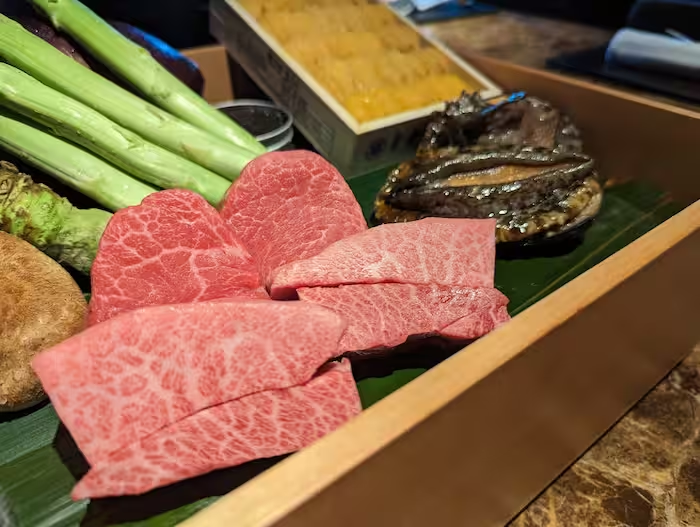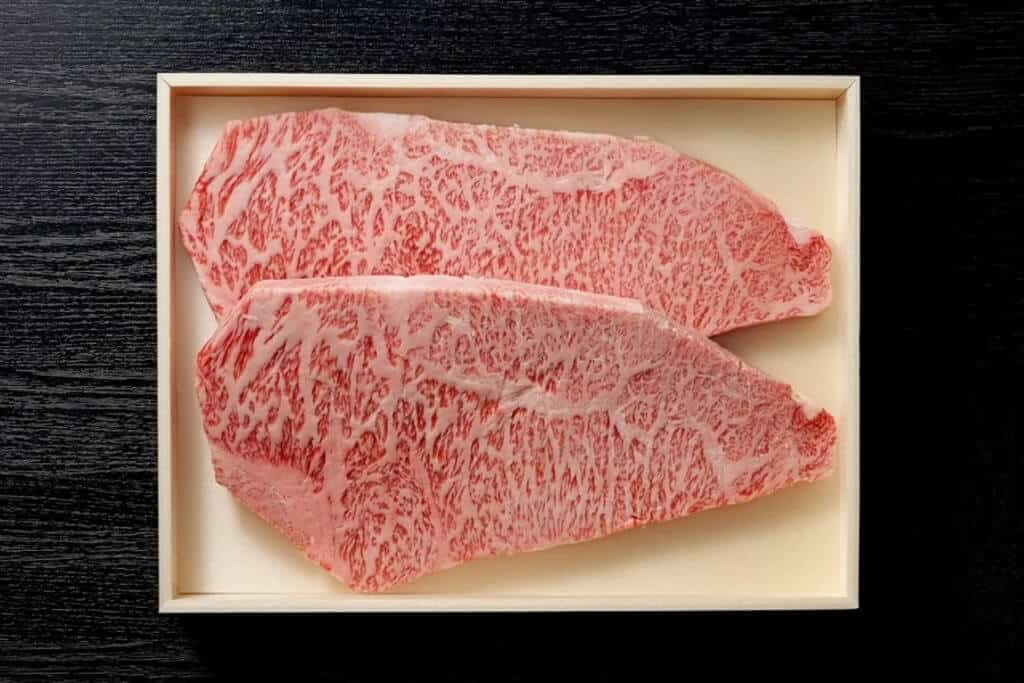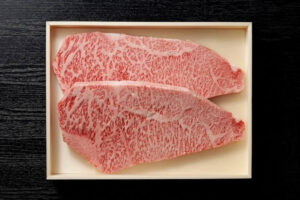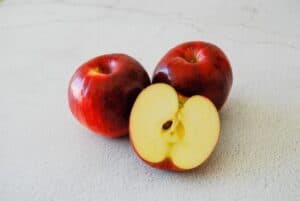When savoring yakiniku, you’ve likely encountered terms like “domestic beef,” “wagyu beef,” “Kuroge wagyu beef,” and “brand beef” on the menu. But what sets them apart, and why does it matter? Understanding the nuances between these types of beef can elevate your dining experience to new heights. Among these beef, there is a type of beef called “Kuroge Wagyu.” However, even if you have heard of the name “Kuroge Wagyu,” few people probably know much about it. Below, we will introduce the characteristics and history of Kuroge Wagyu beef.
What is Kuroge wagyu?

Japan produces approximately 42% of its beef domestically, raising cattle with meticulous care. Farmers predominantly raise Kuroge Wagyu, or Japanese black beef, which symbolizes exceptional quality and flavor. This breed comprises the majority of Wagyu cattle in Japan, featuring stunning marbling that resembles intricate patterns.
Chefs and food enthusiasts celebrate Kuroge Wagyu for its rich flavor and melt-in-your-mouth texture. While farmers raise this beef throughout Japan, regions like Hokkaido, Tohoku, and southern Kyushu particularly excel in its production.
Farmers invest significant time and effort in raising Kuroge Wagyu, as the cattle grow slowly and resist mass production. This careful process makes the beef rare and luxurious, establishing its reputation as one of the world’s finest beef varieties. The high price reflects not just the meat’s quality, but also the extensive dedication required to produce each exceptional cut.
Kuroge wagyu Origin

The Edo Shogunate, which had ruled Japan for over 260 years, ended in 1867 with the “Return of Imperial Rule to the Emperor” and the “Great Proclamation of the Restoration of Imperial Rule.” This marked the start of the Meiji era, a period when foreign cultures and practices began to influence Japan. During this time, demand for beef surged, especially in cities.
In 1900, the Ministry of Agriculture and Commerce started importing foreign cattle breeds and crossbreeding them with native Wagyu, laying the foundation for modern Wagyu cattle. This process continued into the Taisho era, and in 1937, Japanese Black Cattle— the most well-known type of Wagyu. Today, Japanese Black Cattle is celebrated worldwide for its exceptional quality and rich history.
Tajima Beef

Over 97% of Wagyu comprise Japanese black beef or Kuroge beef, with Tajima beef representing the pure bloodline from Hyogo Prefecture. Farmers have bred Tajima cattle in the Tajima region for centuries, originally using them as working cattle for plowing fields and carrying heavy loads.
The Tajima region, situated in northern Hyogo Prefecture near Tottori, includes areas like Toyooka City and Mikata County. Historical records trace the ancestors of Tajima beef back to the Kamakura period. Farmers and beef enthusiasts now celebrate Tajima cattle for their exceptional quality, recognizing them as the foundational bloodline of world-famous Wagyu beef.
This mountainous region’s unique breeding practices and careful cultivation have transformed these once-working cattle into a global culinary treasure, embodying centuries of agricultural expertise and genetic refinement.
How does the taste of Kuroge Wagyu differ from other beef?
Kuroge Wagyu beef has exceptional qualities that set it apart from other types of beef. Its incredibly fine marbling creates a unique sweetness and depth of flavour, with fat that melts effortlessly in the mouth due to its low melting point and high oleic acid content.
The beef has a distinctive sweet flavour and an incredibly smooth texture that seems to dissolve on the tongue. Unlike other beefs, Black Wagyu offers a perfect balance of marbled fat and lean meat for a rich yet nuanced flavour experience. The high fat content contributes to an exceptionally succulent and tender eating experience that is both luxurious and deeply satisfying.
Every bite of Kuroge Wagyu is a culinary journey, showcasing the meticulous breeding and care that goes into producing this premium beef. Its intricate marbling, low-melting fat and complex flavour profile make it a delicacy that truly stands apart from conventional beef, offering a melt-in-your-mouth experience that is both indulgent and sophisticated.
Ranking of Kuroge Wagyu

Many of Japan’s most famous beef brands fall under the category of Japanese Black Beef, known as Kuroge Wagyu. This prestigious category includes beloved names such as Satsuma Beef, Matsusaka Beef, Kobe Beef, Yonezawa Beef, Tajima Beef, and Omi Beef, all of which are renowned for their exceptional quality and flavor.
Kuroge Wagyu often achieves the coveted A5 grade, the highest possible ranking for Wagyu beef. An A5 grade signifies perfect marbling, superior firmness and texture, excellent yield, and an ideal color. Hence. these qualities make Kuroge beef a symbol of luxury and a must-try for anyone seeking the finest Japanese beef experience.
And so, to know more about the beef ranking in Japan, you can check out the article about Wagyu beef.
What is the price range of Kuroge Wagyu?
The price range for Kuroge Wagyu beef varies greatly depending on the part and quality but is generally as follows.
Sirloin
Price Range: 3,000 yen to 5,500 yen per 100g
- Cheap Ones: Start at around 2,600 yen per 100g
- High-End Ones: 5,000 yen or more per 100g
Fillet
Price Range: 4,000 yen to 8,000 yen per 100g
- Cheapest: Starts at around 4,300 yen per 100g
- High-Quality Ones: More than 7,000 yen per 100g, sometimes more than 10,000 yen per 100g
Other Parts (Thighs, Kata, etc.)
Price Range: 1,700 yen to 3,500 yen per 100g
Cut Meat
Price Range: From about 900 yen per 100g
These prices vary according to brand, seller, and rank. In addition, meat for sukiyaki and shabu-shabu tends to be slightly cheaper than that for steak. Kuroge Wagyu beef is more expensive than ordinary Japanese beef (e.g., the Holstein breed), and the price difference for the same portion can be more than 2,000 yen per 100g.

Kuroge Wagyu Restaurants
Ukai-tei Omotesando (表参道 うかい亭)
Ukai-tei Omotesando offers an exquisite teppanyaki experience with premium A5 Wagyu beef. The skilled chefs prepare the meat before your very eyes on a hot iron griddle, ensuring perfect searing and maintaining the beef’s tender, melt-in-your-mouth texture.
Aragawa (麤皮)
Aragawa’s culinary team carefully selects and prepares exceptional Kobe beef in a refined, intimate setting. Chefs charcoal-grill their signature steak to highlight the beef’s intense marbling and rich flavor, creating a legendary dining experience that showcases the pinnacle of Japanese beef preparation.
Niku-Azabu Ebisu (ニクアザブ恵比寿)
Niku-Azabu Ebisu offers a stylish pub atmosphere where you can enjoy Kuroge Wagyu alongside draught beers and wines. Wagyu is served in a variety of styles, from traditional Japanese to fusion dishes such as truffle mashed potatoes.
Summary

If you ever have the chance to visit Japan, don’t miss the opportunity to savor this exceptional beef. Whether it’s grilled to perfection as yakiniku, served as a luxurious steak, or featured in a traditional dish, Kuroge Wagyu promises to elevate your meal. Treat yourself to this world-renowned delicacy and experience firsthand why it’s celebrated globally.
If you are into Japanese wagyu beef, there are many other wagyu beef in Japan for you to try.
















Comments